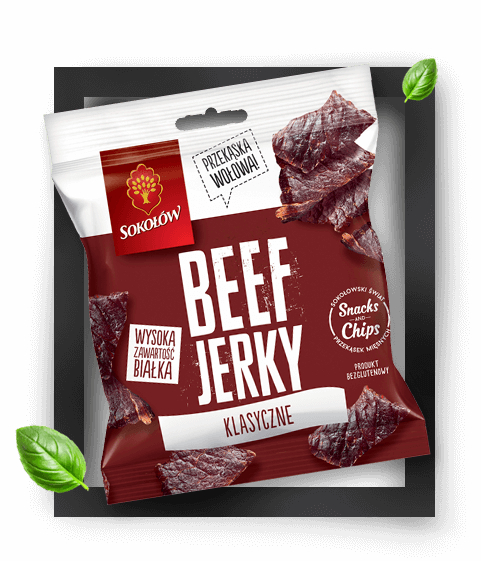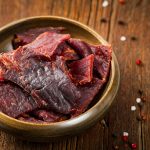1. Introduction to Beef Jerky
1.1 What is Beef Jerky?
Beef jerky is a popular snack that comes in the form of dried, lean meat, typically enjoyed for both its flavor and convenience. The meat undergoes a process of being trimmed of fat, cut into strips, and then dried. This drying process includes marinating the meat in a variety of seasonings and dehydrating it to prevent spoilage, leaving a chewy, savory snack that can last a long time without refrigeration. Beef jerky originates from several cultures around the world, each with its method and unique blend of spices, which has contributed to the wide variety of flavors available on the market today.
1.2 The Nutritional Profile of Beef Jerky
As a snack, beef jerky offers a robust nutritional profile. It is high in protein, which is crucial for muscle repair and building, making jerky an ideal snack for athletes or those pursuing a high-protein diet. It’s also low in carbohydrates, which can be beneficial for those following a keto or low-carb diet plan. However, it’s worth being mindful of the sodium content, as jerky typically includes salt in its marinating process as a preservative, which can be relatively high.
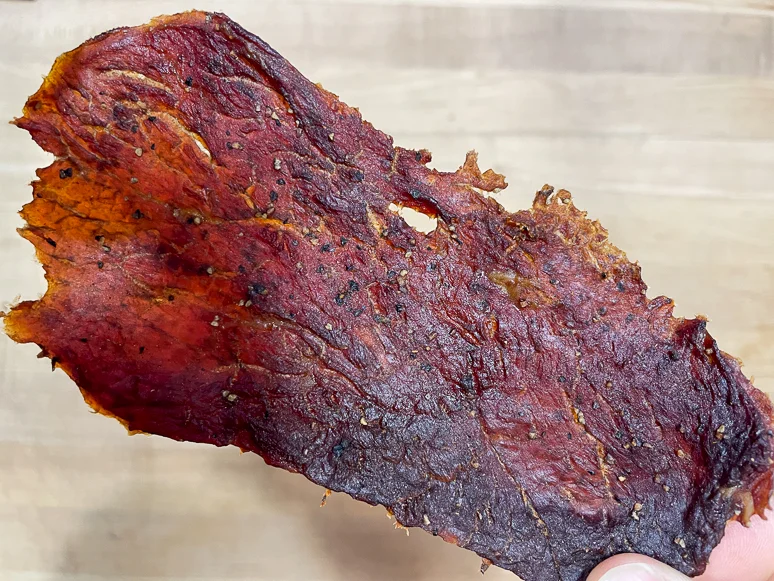
1.3 The Historical Significance of Dried Meat
The art of drying meat dates back centuries and is rooted in the need to preserve meat for long periods, especially in times before refrigeration. Ancient civilizations across the globe developed their methods of drying meat to extend its shelf life and provide a reliable food source during travel, hunting, or periods of scarcity. The word ‘jerky’ is derived from a South American Native Quechua word, “ch’arki,” which means “dried meat”. Historically, the practice of making jerky was not only a means of survival but also an art that was perfected over generations.
2. How Beef Jerky is Made
2.1 Selecting the Right Cut
The beef jerky-making process begins with selecting the right cut of beef. Quality jerky usually comes from lean cuts such as top round, bottom round, or flank steak. Fats do not dehydrate well, and their presence can lead to spoilage, so the leaner the meat, the better the final product. The chosen cut is then trimmed meticulously of any excess fat and prepared into thin slices that will dry uniformly. Attention to this step is key to producing jerky that has the right texture and shelf life.

2.2 The Marinating Process
Marination is crucial for flavoring the meat and preparing it for dehydration. This process typically involves soaking the meat slices in a mixture of sauces and spices for several hours or even days. Common ingredients in the marinade can include soy sauce, Worcestershire sauce, vinegar, liquid smoke, garlic, onion, black pepper, and various other herbs and spices. The marination process not only infuses the meat with flavors but also starts the moisture extraction process, which is vital for creating jerky that is both savory and shelf-stable.
2.3 The Dehydration Method
After marinating, the meat is laid out on racks and placed in a dehydrator or oven, where it will undergo the drying process that is essential to making jerky. The dehydration process involves applying low heat over an extended period – typically several hours. Proper dehydration will remove most of the meat’s moisture, preventing bacterial growth and spoilage. The goal is to achieve a moisture content of less than 10%, which allows for long-term storage without refrigeration. The result is a dry and chewy product that is packed with flavor.
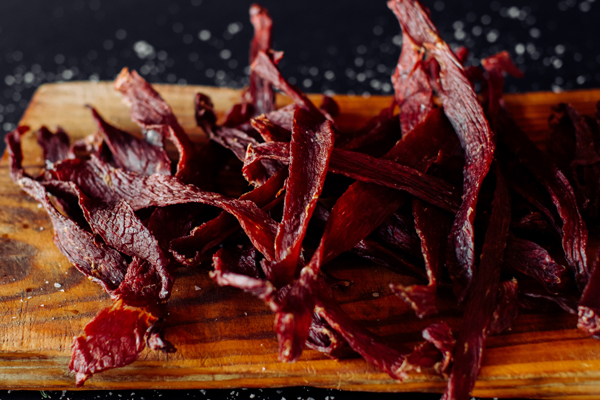
3. Variations and Flavors of Beef Jerky
3.1 Exploring Different Seasonings and Spices
The flavor profile of beef jerky is diverse, with countless recipes and spice combinations that cater to all palates around the world. Some enjoy the heat brought by using chili flakes or cayenne pepper, while others might prefer sweeter notes from ingredients like brown sugar or honey. Teriyaki, barbecue, and black pepper are among the classic flavors, but more adventurous types include habanero, bourbon, and even exotic blends incorporating fruits or truffles. The versatility of jerky spices allows for continuous exploration and palate-pleasing experiences.
3.2 Specialty and Artisanal Varieties
There has been a rise in specialty and artisanal beef jerky offerings, with small-batch producers creating gourmet varieties that showcase high-quality ingredients and unique flavor profiles. These artisanal jerky products often avoid additives and preservatives found in mass-produced versions and focus on organic, grass-fed beef as a base. The explosion of craft jerky makers has given consumers access to an array of handcrafted jerky that pushes the boundaries of traditional jerky flavors.

3.3 Regional and Cultural Interpret
Beef Jerky Across different cultures and regions, beef jerky is known by various names and is made using a wide range of local ingredients that reflect regional tastes and traditions. In South Africa, for example, “biltong” is a form of dried meat that includes vinegar in the marinating process and is typically made from beef or game meats. Across Asia, variations of dried beef snacks incorporate local spices like lemongrass, ginger, and star anise, with textures that can range from soft and tender to the traditional chewy jerky most are familiar with. In North America, the variety of available flavors has seen remarkable growth, incorporating everything from maple-glazed to whiskey-soaked jerky. These regional variations not only add to the rich tapestry of the jerky world but also represent the adaptation of a global preservation technique, each with its unique flavor profile.
4. Consumption and Uses of Beef Jerky
4.1 As a Convenient Snack Option
One of the key reasons for the enduring popularity of beef jerky is its convenience. Packed with high protein and requiring no preparation or refrigeration, jerky is the perfect grab-and-go snack. It’s compact and lightweight, making it a favorite among hikers, campers, and travelers. The long shelf life means it can be stored in pantries, glove compartments, gym bags, and emergency kits, providing a ready source of energy and satiety whenever it’s needed.
4.2 Incorporating Beef Jerky into Recipes
Beyond just snacking, beef jerky can be an imaginative addition to many recipes, introducing a smoky, savory element. It can be chopped and added to trail mixes, salads, baked goods, and even dishes like chili or stews to impart rich, meaty flavors without the need for long cooking times. Jerky can be rehydrated and used as a topping for pizzas or integrated into stuffing for sandwiches and wraps. Its versatility in the kitchen is only limited by the creativity of the cook.
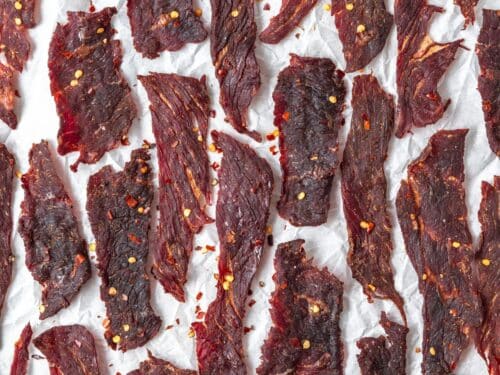
5. The Commercial Industry of Beef Jerky
5.1 The Business of Jerky Production
The beef jerky industry represents a significant segment of the snack foods market, with both large-scale operations and smaller artisanal producers contributing to its growth. This diversity in production scales reflects the varying demand for jerky and its appeal to a broad consumer base. Large brands utilize extensive marketing and distribution networks to reach a wide audience, while artisanal producers often focus on direct online sales or placement in specialty stores. The widespread appeal of beef jerky is continuously expanding in conjunction with the evolving tastes and preferences of consumers.
5.2 Innovation and New Product Development
In response to consumer interest in healthier snacking options and diverse flavors, the beef jerky industry is continually innovating. Product development teams work on creating new flavors and formulations that cater to specific dietary needs, including gluten-free, paleo-friendly, and low-sodium jerky. There’s also a trend toward using alternative meats like turkey, salmon, and even plant-based proteins, which are being processed to mimic the texture and flavor of traditional beef jerky. These new products not only diversify the jerky market but also make it accessible to a wider audience with different dietary preferences and restrictions.
